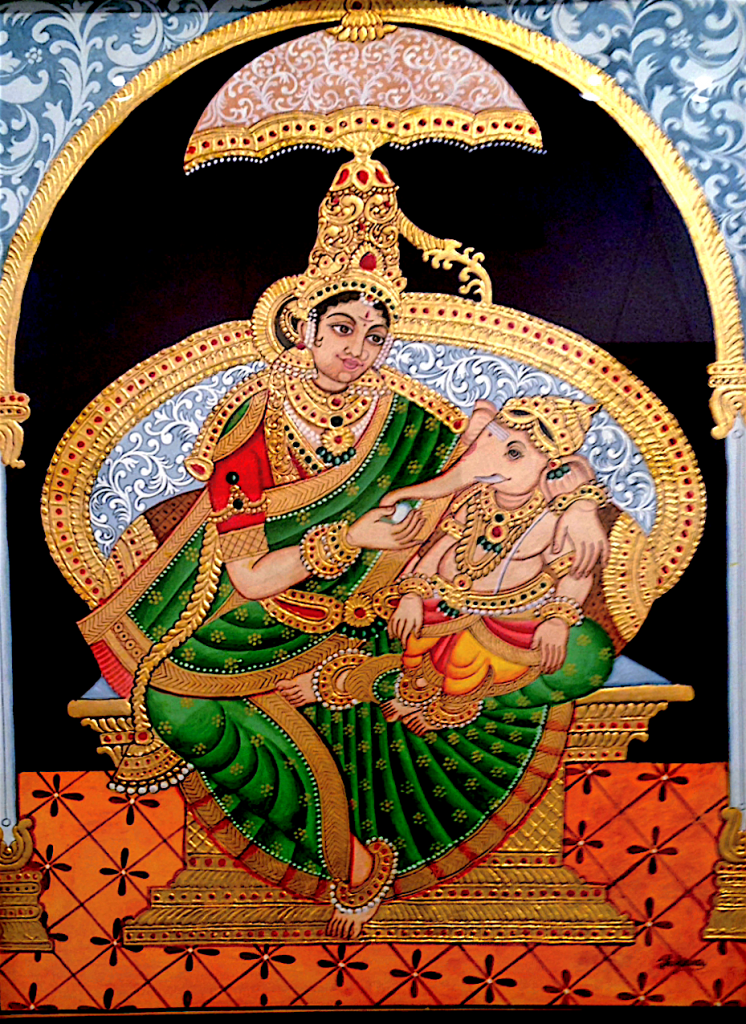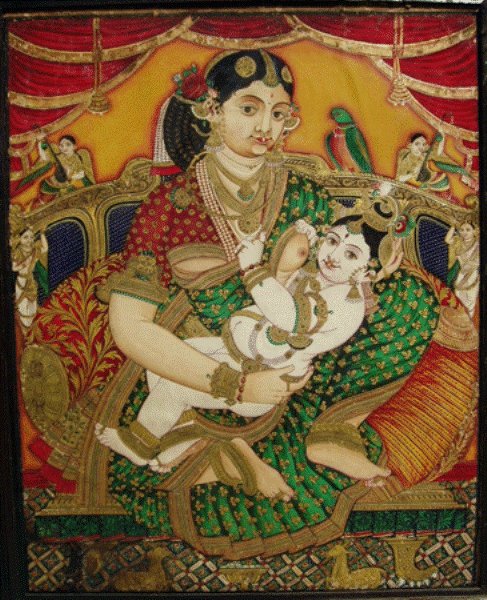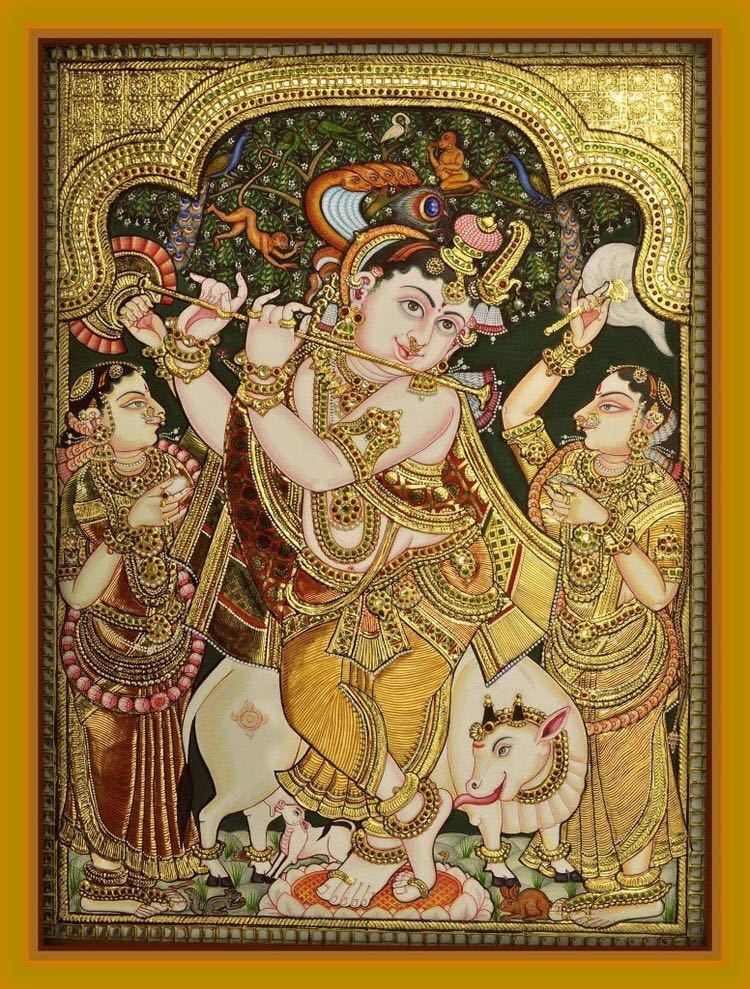ॐ श्री गुरुभ्यो नमः ॐ श्री शिवानन्दाय नमः ॐ श्री चिदानन्दाय नमः ॐ श्री दुर्गायै नमः
Source of all Images in this Blog-post : Google Images : ‘Google Image Search’ will reveal the multiple sources of every single image shared in this Blog. For more details, kindly see ‘Disclaimer‘
Introduction
Mysore paintings, a classical South Indian painting style, originated in the Mysore city of Karnataka. This art form has a rich history that dates back to the Ajanta times, but it gained significant prominence during the reign of the Vijayanagar emperors in the 15th century.
Buy Most Exquisite Pieces of Mysore Paintings Online on Artisera
Historical Roots and Evolution
The origin of Mysore paintings can be traced back to the Ajanta times, but the style as we know it today was heavily influenced by the Vijayanagar School of painting in the 15th century. The fall of the Vijayanagar Empire in the 16th century led to the migration of painters who specialized in this style to various places, including Mysore, which then became a significant center for this art form.
During the rule of the Wodeyar dynasty in Mysore, this art style received royal patronage and evolved with unique characteristics. The Wodeyar kings, known for their love of art and culture, played a pivotal role in the development and preservation of Mysore paintings.
Characteristics of Mysore Paintings
Mysore paintings are known for their elegance, muted colors, and attention to detail. The main characteristics include:
- Use of Gold: Gold foil is extensively used, giving these paintings a rich look.
- Themes: The themes are mostly drawn from Hindu mythology, epics, and religious texts.
- Gesso Work: The use of gesso, a mixture of zinc oxide and Arabic gum, to give an embossed look to certain aspects of the painting.
- Fine Lines and Meticulous Detailing: The paintings are known for their intricate brushwork.
The Process of Making Mysore Paintings
Creating a Mysore painting involves multiple steps:
- Preparation of the Canvas: The canvas is prepared by applying a mixture of zinc oxide and gum to make it stiff.
- Sketching: The artist draws a detailed sketch.
- Applying Colors: Natural pigments are used for coloring. The colors are applied in layers, enhancing the painting’s depth.
- Gesso Work: Gesso is used to create relief work, especially in ornaments and architectural elements.
- Gold Foiling: Gold leaves are then pasted onto the designated areas.
- Finishing Touches: Finally, the painting is given finishing touches to highlight details.
Cultural Significance
Mysore paintings are more than just art; they are a part of South India’s rich cultural tapestry. They reflect the religious and philosophical ethos of the time, depicting scenes from Hindu mythology, saints, and divine characters in intricate detail, often with symbolic meanings.
Buy Mysore Paintings Online on Google Shopping
Buy Most Exquisite Pieces of Mysore Paintings Online on Artisera
Modern Adaptations and Global Recognition
In the modern era, while the traditional themes continue to be popular, artists have started incorporating contemporary elements and experimenting with new techniques. Mysore paintings have gained international recognition, with artists and connoisseurs appreciating the skill and intricacy involved in this art form.

Preservation and Revival Efforts
Efforts are being made to preserve and revive Mysore paintings. The Government of India, art institutions, and private collectors play a significant role in this. Workshops, exhibitions, and training programs are conducted to keep this ancient art form alive and relevant.
Conclusion
Mysore paintings are a testament to India’s rich artistic heritage. From the royal courts of Mysore to the global stage, these paintings continue to enchant art lovers around the world. Their journey from a regional art form to an internationally recognized symbol of Indian cultural heritage is a remarkable story of resilience, evolution, and enduring beauty.

Difference Between Mysore Paintings & Tanjore Paintings
Mysore and Tanjore paintings are two prominent classical South Indian painting styles with distinct characteristics and histories. While they share some similarities, such as their roots in Hindu religion and mythology and their use of gold, there are several key differences between them.
Origin and History
- Mysore Paintings: Originating in the city of Mysore in Karnataka, these paintings developed under the patronage of the Vijayanagar emperors and later flourished under the Wodeyars of Mysore.
- Tanjore Paintings: Tanjore (or Thanjavur) paintings originated in the town of Thanjavur in Tamil Nadu. They began in the 16th century, during the reign of the Chola dynasty and were also influenced by the Maratha rule, Nayakas, and even the European settlers.
Artistic Techniques and Style
- Mysore Paintings: Known for their elegance and subtlety, Mysore paintings are characterized by delicate lines and intricate brushwork. The paintings have a softer and smoother appearance, with an emphasis on detail.
- Tanjore Paintings: Tanjore paintings are known for their vivid colors and dense composition. They typically feature rich and vibrant colors, with an extensive use of gold foil. These paintings are more opulent and embellished compared to Mysore paintings.
Use of Gold and Embossing
- Mysore Paintings: Gold is used more sparingly in Mysore paintings, mainly to highlight certain elements. The gold work is usually flat, without much embossing.
- Tanjore Paintings: Tanjore paintings are famous for their extensive use of gold foil and precious stones. The gold foil is often laid over gesso work, which gives the paintings a three-dimensional embossed effect.
Themes and Subjects
- Mysore Paintings: While both styles focus on Hindu gods, goddesses, and mythology, Mysore paintings often have a more religious and philosophical undertone, with a focus on finer details.
- Tanjore Paintings: Tanjore art often depicts deities in a very grand and majestic manner, filled with symbolism and iconography. The figures in Tanjore paintings are usually larger and more ornate.
Canvas Preparation
- Mysore Paintings: The canvas is typically prepared with a paste made from zinc oxide and Arabic gum, over which the drawing is made.
- Tanjore Paintings: The preparation involves a cloth pasted over a wooden base, followed by a layer of chalk powder and a binder. This creates a thicker base compared to Mysore paintings.
Contemporary Influence and Popularity
- Mysore Paintings: These have remained more traditional in their approach, with artists generally adhering closely to ancient techniques and styles.
- Tanjore Paintings: Tanjore art has seen more commercialization and adaptation, with the style being used in modern artifacts and decor items.
- Conclusion
- Both Mysore and Tanjore paintings are invaluable parts of India’s artistic heritage, each with its unique charm and significance. While Mysore paintings are known for their refined elegance and subtle detailing, Tanjore paintings are celebrated for their grandeur, vivid colors, and rich embellishments.
Conclusion
Both Mysore and Tanjore paintings are invaluable parts of India’s artistic heritage, each with its unique charm and significance. While Mysore paintings are known for their refined elegance and subtle detailing, Tanjore paintings are celebrated for their grandeur, vivid colors, and rich embellishments.
Buy Mysore Paintings Online on Google Shopping

National Award Winners
Several renowned Mysore painting artists have achieved national recognition and awards for their contributions to this traditional art form. One of the most notable artists is Y. Subramanya Raju, who has an illustrious career marked by significant achievements and contributions. He is known for his work in the Kalyana Mantapa of the Mysore Palace and has received several awards, including a Gold Medal for the “Dasara Exhibition Poster” in 1931, and the Karnataka State Lalithakala academy prize in 1962.
Another prominent artist in the field of Mysore paintings is Shobana Udayasankar, who has been an active advocate for this art form. She specializes in capturing traditional, mythological subjects and events that are the mainstay of Mysore art through rare, technically authentic depictions. Her mission is to revive interest in the Mysore style by making it accessible and relevant to contemporary audiences. Shobana is a recipient of the Karnataka Lalitkala Akademi Millennium award.
Additionally, the D’source website lists several other famous Mysore artists, including Sri K.S. Shreehari, M. Ramanarasaiah, Ms. Chandrika, Mr. Anand, and B.P. Ramakrishna. These artists have contributed significantly to the preservation and promotion of Mysore painting, each bringing their unique style and expertise to this traditional art form.
These artists, through their dedication and skill, have played a crucial role in keeping the rich tradition of Mysore paintings alive and relevant in the modern world.
Buy Mysore Paintings Online on Google Shopping

Buy Most Exquisite Pieces of Mysore Paintings Online on Artisera


Buy Most Exquisite Pieces of Mysore Paintings Online on Artisera

Watch a Series of Videos on Mysore Paintings Including Tutorials on Google Videos
Buy Most Exquisite Pieces of Mysore Paintings Online on Artisera

Read more at: https://www.deccanherald.com/content/529089/strokes-tradition.html

Watch a Series of Videos on Mysore Paintings Including Tutorials on Google Videos

Watch a Series of Videos on Mysore Paintings Including Tutorials on Google Videos


Watch a Series of Videos on Mysore Paintings Including Tutorials on Google Videos






2 replies on “From the Royal Courts to the Wider World: The Story of Mysore Paintings”
Wonderful read!
The ‘Raas Leela’ and ‘Maa Saraswati’ are the works of Mrs. M Girija from Mysuru. You can visit her gallery or get in touch with her.
https://instagram.com/girijamanjanath?igshid=NTc4MTIwNjQ2YQ==
I am happy you shared this information, Ramya. It will be very useful to my readers.